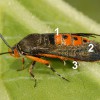 Squash vine borer is a moth species that is active during the day (diurnal). The larvae complete their growth and development on wild and domesticated species of the genus Cucurbita. Once only considered a nuisance to commercial growers, with the expansion of cucurbit production in the United States over the last decade, the squash vine borer has become a pest of economic importance. This 5-page fact sheet was written by Eutychus Kariuki and Jennifer L. Gillett-Kaufman, and published by the UF Department of Entomology and Nematology, December 2014. (Photo: Lyle J. Buss, UF/IFAS)
Squash vine borer is a moth species that is active during the day (diurnal). The larvae complete their growth and development on wild and domesticated species of the genus Cucurbita. Once only considered a nuisance to commercial growers, with the expansion of cucurbit production in the United States over the last decade, the squash vine borer has become a pest of economic importance. This 5-page fact sheet was written by Eutychus Kariuki and Jennifer L. Gillett-Kaufman, and published by the UF Department of Entomology and Nematology, December 2014. (Photo: Lyle J. Buss, UF/IFAS)
http://edis.ifas.ufl.edu/in1068
Category: Agriculture
Rice Bug (suggested common name) Leptocorisa acuta (Thunberg) (Insecta: Hemiptera: Alydidae)
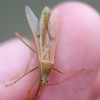 Broad-headed bugs belong to a well-known but relatively small family of plant-feeding true bugs, usually seen feeding on the foliage and flowers of leguminous and graminaceous crops. Leptocorisa acuta (Thunberg) can be found on many crop plants in the family Poaceae (grasses), especially rice, and is a reported pest of economic significance in rice-producing countries like India, Australia, and China. This 3-page fact sheet was written by Amelio Chi Serrano, Russell F. Mizell, III, and Morgan A. Byron, and published by the UF Department of Entomology and Nematology, December 2014. (Photo: Lary E. Reeves, UF/IFAS)
Broad-headed bugs belong to a well-known but relatively small family of plant-feeding true bugs, usually seen feeding on the foliage and flowers of leguminous and graminaceous crops. Leptocorisa acuta (Thunberg) can be found on many crop plants in the family Poaceae (grasses), especially rice, and is a reported pest of economic significance in rice-producing countries like India, Australia, and China. This 3-page fact sheet was written by Amelio Chi Serrano, Russell F. Mizell, III, and Morgan A. Byron, and published by the UF Department of Entomology and Nematology, December 2014. (Photo: Lary E. Reeves, UF/IFAS)
http://edis.ifas.ufl.edu/in1067
Wellsina Mite Hemicheyletia wellsina (De Leon) (Arachnida: Acari: Cheyletidae)
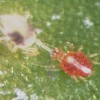 This predatory mite was recently discovered in an unsprayed greenhouse at the University of Florida, Gainesville, living on Phalaenopsis and Dendrobium orchids, and assumed to be feeding on orchid pests such as spider mites, tenuipalpid mites, and mealybugs that were present on the orchids. Because there was no published information on this species as a natural enemy of orchid pests, colonies were initiated here to study its biology, maintained on two-spotted spider mite prey. Hemicheyletia wellsina does not appear likely to be an effective natural enemy in agricultural crops as an introduced predator, but could be beneficial in natural biological control in natural ecosystems, where pest densities are lower. This 5-page fact sheet was written by Haleigh A. Ray and Marjorie A. Hoy, and published by the UF Department of Entomology and Nematology, December 2014. (Photo: Haleigh Ray, UF/IFAS)
This predatory mite was recently discovered in an unsprayed greenhouse at the University of Florida, Gainesville, living on Phalaenopsis and Dendrobium orchids, and assumed to be feeding on orchid pests such as spider mites, tenuipalpid mites, and mealybugs that were present on the orchids. Because there was no published information on this species as a natural enemy of orchid pests, colonies were initiated here to study its biology, maintained on two-spotted spider mite prey. Hemicheyletia wellsina does not appear likely to be an effective natural enemy in agricultural crops as an introduced predator, but could be beneficial in natural biological control in natural ecosystems, where pest densities are lower. This 5-page fact sheet was written by Haleigh A. Ray and Marjorie A. Hoy, and published by the UF Department of Entomology and Nematology, December 2014. (Photo: Haleigh Ray, UF/IFAS)
http://edis.ifas.ufl.edu/in1066
Yellowmargined Leaf Beetle: A Pest of Cole Crops
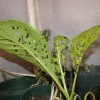 The yellowmargined leaf beetle is a pest of cole or cruciferous crops that is native to South America. Since first reported in Mobile, Alabama, in 1947, the beetle has spread throughout the Gulf Coast from Texas to Florida and up into Georgia and North Carolina. It has also been reported from Illinois and California. Not considered a major pest in conventionally grown cruciferous crops because it is susceptible to a wide range of insecticides, it poses a significant threat to the growing organic industry in the southeastern United States. It is a particular problem on Asian greens such as mizuna, mibuna, and napa cabbage, as well as on other high-value cruciferous crops like turnip, mustard, and watercress. This 4-page fact sheet was written by Elena M. Rhodes and and Oscar E. Liburd, and published by the UF Department of Entomology and Nematology, September 2014.
The yellowmargined leaf beetle is a pest of cole or cruciferous crops that is native to South America. Since first reported in Mobile, Alabama, in 1947, the beetle has spread throughout the Gulf Coast from Texas to Florida and up into Georgia and North Carolina. It has also been reported from Illinois and California. Not considered a major pest in conventionally grown cruciferous crops because it is susceptible to a wide range of insecticides, it poses a significant threat to the growing organic industry in the southeastern United States. It is a particular problem on Asian greens such as mizuna, mibuna, and napa cabbage, as well as on other high-value cruciferous crops like turnip, mustard, and watercress. This 4-page fact sheet was written by Elena M. Rhodes and and Oscar E. Liburd, and published by the UF Department of Entomology and Nematology, September 2014.
http://edis.ifas.ufl.edu/in1049
Hairy Indigo Control in Peanut
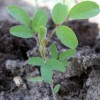 Hairy indigo is an annual legume that was introduced to Florida as a forage crop. It has since escaped cultivation and can be a troublesome weed in some crop settings, particularly in peanut production, since we are attempting to control a legume weed in a legume crop. This 2-page fact sheet was written by Jason Ferrell, Blaire Colvin, and Ramon Leon, and published by the UF Department of Agronomy, March 2015. (Photo by Blaire Colvin, UF/IFAS)
Hairy indigo is an annual legume that was introduced to Florida as a forage crop. It has since escaped cultivation and can be a troublesome weed in some crop settings, particularly in peanut production, since we are attempting to control a legume weed in a legume crop. This 2-page fact sheet was written by Jason Ferrell, Blaire Colvin, and Ramon Leon, and published by the UF Department of Agronomy, March 2015. (Photo by Blaire Colvin, UF/IFAS)
http://edis.ifas.ufl.edu/ag391
Selecting Cultivars of Lettuce For Production Using Hydroponics and Protected Culture in Florida
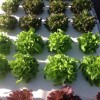 With correct variety selection and protected culture strategies, lettuce is a crop that can present even the novice grower with a fast-growing commodity for market sale. Includes brief descriptions of hydroponic lettuce production systems, cultivars, and a table summarizing the lettuce types successfully grown in Florida using protected agriculture and hydroponic techniques. This 6-page fact sheet was written by Natalie B. Parkell, Robert C. Hochmuth, and Wanda L. Laughlin, and published by the UF Department of Horticultural Sciences, March 2015. (Photo: UF/IFAS)
With correct variety selection and protected culture strategies, lettuce is a crop that can present even the novice grower with a fast-growing commodity for market sale. Includes brief descriptions of hydroponic lettuce production systems, cultivars, and a table summarizing the lettuce types successfully grown in Florida using protected agriculture and hydroponic techniques. This 6-page fact sheet was written by Natalie B. Parkell, Robert C. Hochmuth, and Wanda L. Laughlin, and published by the UF Department of Horticultural Sciences, March 2015. (Photo: UF/IFAS)
http://edis.ifas.ufl.edu/hs1258
Nutrient Management of Vegetable and Agronomic Row Crops Handbook
 Through the implementation of a series of targeted cultural practices discussed in this production guide, growers should be able to reconcile economic profitability and responsible use of water and fertilizer. Topics include: proper sampling practices and test interpretations; irrigation management methods and automation; use of alternate fertilizer materials to retain nutrients in the soil but allow adequate supply for crop uptake. Use of these BMPs ensures that adequate fertilizer rates may be achieved by combinations of UF/IFAS recommended base rates and supplemental fertilizer applications. This 199-page handbook was edited by Kelly T. Morgan, and published by the UF Department of Soil and Water Science, February 2015.
Through the implementation of a series of targeted cultural practices discussed in this production guide, growers should be able to reconcile economic profitability and responsible use of water and fertilizer. Topics include: proper sampling practices and test interpretations; irrigation management methods and automation; use of alternate fertilizer materials to retain nutrients in the soil but allow adequate supply for crop uptake. Use of these BMPs ensures that adequate fertilizer rates may be achieved by combinations of UF/IFAS recommended base rates and supplemental fertilizer applications. This 199-page handbook was edited by Kelly T. Morgan, and published by the UF Department of Soil and Water Science, February 2015.
http://edis.ifas.ufl.edu/ss639
Contribucion de las practicas de produccion de cultivos y las condiciones climaticas a la seguridad microbiologica de los tomates y pimientos
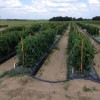 Durante la última década, las frutas, verduras y frutos secos se encuentran entre los alimentos relacionados con brotes de gastroenteritis causadas por cepas enterovirulentas de E. coli y Salmonella no tifoidea que resultan en miles de hospitalizaciones y pérdidas de varios millones de dólares en la industria de alimentos (Mandrell 2009; Batz, Hoffman, y Morris 2011). Desde 2006, dieciséis brotes de salmonelosis se han relacionado con el consumo de frutas y verduras, incluyendo tomates, melones, coles, pepinos, mangos, piñones, pistachos, mantequilla de maní, papayas, pimientos y además alimentos congelados y procesados que contienen productos vegetales. Esta hoja informativa fue producida para proveer información actualizada sobre las prácticas de producción de tomate y sus asociaciones con Salmonella. Esta información es útil para Agentes de Extensión Agraria en sus programas de educación sobre cultivos hortícolas. This 4-page fact sheet is the Spanish language version of The Role of Crop Production Practices and Weather Conditions in Microbiological Safety of Tomatoes and Peppers (SS628). It was written by Massimiliano Marvasi, Max Teplitski, and George Hochmuth, and published by the UF Department of Soil and Water Science, February 2015.
Durante la última década, las frutas, verduras y frutos secos se encuentran entre los alimentos relacionados con brotes de gastroenteritis causadas por cepas enterovirulentas de E. coli y Salmonella no tifoidea que resultan en miles de hospitalizaciones y pérdidas de varios millones de dólares en la industria de alimentos (Mandrell 2009; Batz, Hoffman, y Morris 2011). Desde 2006, dieciséis brotes de salmonelosis se han relacionado con el consumo de frutas y verduras, incluyendo tomates, melones, coles, pepinos, mangos, piñones, pistachos, mantequilla de maní, papayas, pimientos y además alimentos congelados y procesados que contienen productos vegetales. Esta hoja informativa fue producida para proveer información actualizada sobre las prácticas de producción de tomate y sus asociaciones con Salmonella. Esta información es útil para Agentes de Extensión Agraria en sus programas de educación sobre cultivos hortícolas. This 4-page fact sheet is the Spanish language version of The Role of Crop Production Practices and Weather Conditions in Microbiological Safety of Tomatoes and Peppers (SS628). It was written by Massimiliano Marvasi, Max Teplitski, and George Hochmuth, and published by the UF Department of Soil and Water Science, February 2015.
http://edis.ifas.ufl.edu/ss630
Impacto de las variedades de tomate y su estado de madurez en la susceptibilidad a Salmonella
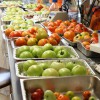 De 1998 a 2007 la fruta fresca, verdura, especias y nueces fueron comúnmente asociados con brotes de gastroenteritis (Batz, Hoffman, y Morris 2011). Salmonella se ha convertido en uno de los patógenos humanos más problemáticos asociado a productos frescos, nueces y a los alimentos que contienen esos ingredientes (Batz, Hoffman, y Morris 2011; deWaal, Tian, y Plunkett 2009). Esta hoja informativa fue producida para proveer información actualizada sobre las prácticas de producción de tomate y sus asociaciones con Salmonella. Esta información es útil para los Agentes de Extensión Agraria en sus programas de educación sobre cultivos hortícolas. This 3-page fact sheet is the Spanish language version of Impact of Tomato Varieties and Maturity State on Susceptibility of Tomatoes to Salmonella (SS627). It was written by Massimiliano Marvasi, Max Teplitski, and George Hochmuth, and published by the UF Department of Soil and Water Science, February 2015. (Photo: Max Teplitski)
De 1998 a 2007 la fruta fresca, verdura, especias y nueces fueron comúnmente asociados con brotes de gastroenteritis (Batz, Hoffman, y Morris 2011). Salmonella se ha convertido en uno de los patógenos humanos más problemáticos asociado a productos frescos, nueces y a los alimentos que contienen esos ingredientes (Batz, Hoffman, y Morris 2011; deWaal, Tian, y Plunkett 2009). Esta hoja informativa fue producida para proveer información actualizada sobre las prácticas de producción de tomate y sus asociaciones con Salmonella. Esta información es útil para los Agentes de Extensión Agraria en sus programas de educación sobre cultivos hortícolas. This 3-page fact sheet is the Spanish language version of Impact of Tomato Varieties and Maturity State on Susceptibility of Tomatoes to Salmonella (SS627). It was written by Massimiliano Marvasi, Max Teplitski, and George Hochmuth, and published by the UF Department of Soil and Water Science, February 2015. (Photo: Max Teplitski)
http://edis.ifas.ufl.edu/ss629
Robbing Behavior in Honey Bees
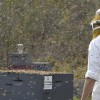 Western honey bee workers can invade and steal honey/nectar from other colonies or sugar/corn syrup from feeders used to deliver syrup to other colonies. This is called “robbing” behavior. Robbing behavior typically involves the collection of nectar and honey, but not pollen or brood. Some beekeepers report that robbing bees may steal wax or propolis from other hives, but there is not much data available on this occurrence. Robbing behavior can escalate quickly from just a few bees robbing other colonies to a massive frenzy of bees robbing many colonies in an apiary. This 3-page fact sheet was written by Ryan Willingham, Jeanette Klopchin, and James Ellis, and published by the UF Department of Entomology and Nematology, February 2015. (Photo Credit: UF/HBREL)
Western honey bee workers can invade and steal honey/nectar from other colonies or sugar/corn syrup from feeders used to deliver syrup to other colonies. This is called “robbing” behavior. Robbing behavior typically involves the collection of nectar and honey, but not pollen or brood. Some beekeepers report that robbing bees may steal wax or propolis from other hives, but there is not much data available on this occurrence. Robbing behavior can escalate quickly from just a few bees robbing other colonies to a massive frenzy of bees robbing many colonies in an apiary. This 3-page fact sheet was written by Ryan Willingham, Jeanette Klopchin, and James Ellis, and published by the UF Department of Entomology and Nematology, February 2015. (Photo Credit: UF/HBREL)
http://edis.ifas.ufl.edu/in1064
Economic Impacts of Highway Beautification in Florida
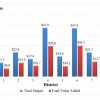 The Florida Department of Transportation is allocated money every year for highway landscaping projects. They make driving more pleasant and are better for the environment, but do they attract private investment and contribute to the economy? This study, commissioned by the FDOT, finds that the average annual economic impacts of highway beautification expenditures in Florida during 2008–2013 amounted to $46 million in output impacts and $28 million in value-added impacts. This 7-page fact sheet was written by Hayk Khachatryan, Alan W. Hodges, Mohammad Rahmani, and Thomas J. Stevens, and published by the UF Department of Food and Resource Economics, December 2014.
The Florida Department of Transportation is allocated money every year for highway landscaping projects. They make driving more pleasant and are better for the environment, but do they attract private investment and contribute to the economy? This study, commissioned by the FDOT, finds that the average annual economic impacts of highway beautification expenditures in Florida during 2008–2013 amounted to $46 million in output impacts and $28 million in value-added impacts. This 7-page fact sheet was written by Hayk Khachatryan, Alan W. Hodges, Mohammad Rahmani, and Thomas J. Stevens, and published by the UF Department of Food and Resource Economics, December 2014.
http://edis.ifas.ufl.edu/fe963
Smutgrass Control in Perennial Grass Pastures
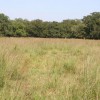 Smutgrass is a serious weed of improved perennial grass pastures, roadsides, natural areas, and waste areas in Florida. A 2003 survey found that smutgrass was second only to tropical soda apple as the most problematic weed species in Florida pastures, but now that practices to control tropical soda apple have been widely adopted in Florida, smutgrass is likely the most problematic weed species in Florida pastures today. This 4-page fact sheet was written by Brent Sellers, J. A. Ferrell, and N. Rana, and published by the UF Department of Agronomy, January 2015. (Photo Credit: B. Sellers, UF/IFAS)
Smutgrass is a serious weed of improved perennial grass pastures, roadsides, natural areas, and waste areas in Florida. A 2003 survey found that smutgrass was second only to tropical soda apple as the most problematic weed species in Florida pastures, but now that practices to control tropical soda apple have been widely adopted in Florida, smutgrass is likely the most problematic weed species in Florida pastures today. This 4-page fact sheet was written by Brent Sellers, J. A. Ferrell, and N. Rana, and published by the UF Department of Agronomy, January 2015. (Photo Credit: B. Sellers, UF/IFAS)
http://edis.ifas.ufl.edu/aa261
Urban Pests and Pest Management
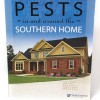 The warm southern states provide an ideal environment for a wide variety of pests — and because almost everyone has problems with pests, most urban areas are sprayed with pesticides. 30 to 40 percent of pesticide use is in urban areas, but most pesticide applications are unnecessary and can result in environmental contamination and human exposure to pesticides. This 5-page fact sheet from Pests in and around the Southern Home introduces integrated pest management practices that can help reduce pesticide use in the home. Written by P.G. Koehler, and published by the UF Department of Entomology and Nematology, October 2013.
The warm southern states provide an ideal environment for a wide variety of pests — and because almost everyone has problems with pests, most urban areas are sprayed with pesticides. 30 to 40 percent of pesticide use is in urban areas, but most pesticide applications are unnecessary and can result in environmental contamination and human exposure to pesticides. This 5-page fact sheet from Pests in and around the Southern Home introduces integrated pest management practices that can help reduce pesticide use in the home. Written by P.G. Koehler, and published by the UF Department of Entomology and Nematology, October 2013.
http://edis.ifas.ufl.edu/in1073
Biology and Management of Eclipta (Eclipta prostrata) in Ornamental Crop Production
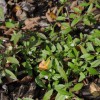 Eclipta grows aggressively in containers and can outcompete nursery crops for water, nutrients, and light. Plants flower in as little as five weeks after germination and produce thousands of seeds over the course of a growing season, and stem fragments left on the soil or media surface following hand-weeding or cultivation can root and reproduce vegetatively. This 4-page fact sheet describes the plant, its biology, and recommendations for physical, cultural, and chemical control. Written by Chris Marble, Shawn Steed, and Nathan S. Boyd, and published by the UF Department of Environmental Horticulture, January 2015. (Photo: Annette Chandler, UF/IFAS)
Eclipta grows aggressively in containers and can outcompete nursery crops for water, nutrients, and light. Plants flower in as little as five weeks after germination and produce thousands of seeds over the course of a growing season, and stem fragments left on the soil or media surface following hand-weeding or cultivation can root and reproduce vegetatively. This 4-page fact sheet describes the plant, its biology, and recommendations for physical, cultural, and chemical control. Written by Chris Marble, Shawn Steed, and Nathan S. Boyd, and published by the UF Department of Environmental Horticulture, January 2015. (Photo: Annette Chandler, UF/IFAS)
http://edis.ifas.ufl.edu/ep512
Biology and Management of Hairy Bittercress (Cardamine hirsute) in Ornamental Crop Production
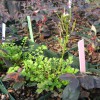 Bittercress commonly grows in the potting media of container-grown ornamentals and often through drainage holes in nursery containers. It also can be a problem in propagation houses, greenhouses, and in the field. This 6-page fact sheet provides species description, plant biology, and management recommendations. Written by Chris Marble, Shawn Steed, and Nathan S. Boyd, and published by the UF Department of Environmental Horticulture, December 2014.
Bittercress commonly grows in the potting media of container-grown ornamentals and often through drainage holes in nursery containers. It also can be a problem in propagation houses, greenhouses, and in the field. This 6-page fact sheet provides species description, plant biology, and management recommendations. Written by Chris Marble, Shawn Steed, and Nathan S. Boyd, and published by the UF Department of Environmental Horticulture, December 2014.
http://edis.ifas.ufl.edu/ep511
Control of Rapid Postharvest Decays of Tomato Fruit
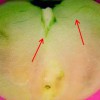 What is a rapid postharvest decay? Water-soaked lesions begin within 12 to 18 hours after harvest and continue to develop, producing large amounts of fluids. The decay spreads within cartons of tomatoes, producing wet patches in the bottom and sides of the container, a condition called “wet-boxes.” Affected fruit are out-of-grade either prior to shipment or upon arrival at the receiver.This 5-page fact sheet was written by J. A. Bartz, S. A. Sargent, and D. J. Huber, and published by the UF Department of Horticultural Sciences, December 2014. (Photo: S. R. Bartz)
What is a rapid postharvest decay? Water-soaked lesions begin within 12 to 18 hours after harvest and continue to develop, producing large amounts of fluids. The decay spreads within cartons of tomatoes, producing wet patches in the bottom and sides of the container, a condition called “wet-boxes.” Affected fruit are out-of-grade either prior to shipment or upon arrival at the receiver.This 5-page fact sheet was written by J. A. Bartz, S. A. Sargent, and D. J. Huber, and published by the UF Department of Horticultural Sciences, December 2014. (Photo: S. R. Bartz)
http://edis.ifas.ufl.edu/hs363
Wedge-Shaped Beetles (suggested common name) Ripiphorus spp. (Insecta: Coleoptera: Ripiphoridae)
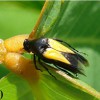 Ripiphoridae are a family of unusual parasitic beetles that are thought to be related to tumbling flower beetles and blister beetles. They parasitize bees and wasps, roaches, and wood-boring beetles, but specific hosts for many ripiphorid species are unknown. Their secretive life cycle makes an assessment of their economic and ecological impact very difficult. Additional research is necessary to determine the abundance and impact of Ripiphorus species. This 4-page fact sheet was written by David Owens, Ashley N. Mortensen, Jeanette Klopchin, William Kern, and Jamie D. Ellis, and published by the UF Department of Entomology and Nematology, December 2014.
Ripiphoridae are a family of unusual parasitic beetles that are thought to be related to tumbling flower beetles and blister beetles. They parasitize bees and wasps, roaches, and wood-boring beetles, but specific hosts for many ripiphorid species are unknown. Their secretive life cycle makes an assessment of their economic and ecological impact very difficult. Additional research is necessary to determine the abundance and impact of Ripiphorus species. This 4-page fact sheet was written by David Owens, Ashley N. Mortensen, Jeanette Klopchin, William Kern, and Jamie D. Ellis, and published by the UF Department of Entomology and Nematology, December 2014.
http://edis.ifas.ufl.edu/in1069
Flower Thrips in Blackberries in Florida
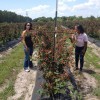 Blackberry production is a small but growing industry in the state of Florida. Their numerous health benefits make them a good choice for Florida growers who want to diversify from traditional crops such as strawberries. Several potential pest insects and mites have been found on blackberries in Florida, but the two most likely to become key pests are stink bugs and flower thrips. This 3-page fact sheet provides information on flower thrips identification, monitoring and management for blackberries. Written by Oscar E. Liburd, Elena M. Rhodes, Elke Weibelzahl, and Sara E. Brennan, and published by the UF Department of Entomology and Nematology, November 2014.
Blackberry production is a small but growing industry in the state of Florida. Their numerous health benefits make them a good choice for Florida growers who want to diversify from traditional crops such as strawberries. Several potential pest insects and mites have been found on blackberries in Florida, but the two most likely to become key pests are stink bugs and flower thrips. This 3-page fact sheet provides information on flower thrips identification, monitoring and management for blackberries. Written by Oscar E. Liburd, Elena M. Rhodes, Elke Weibelzahl, and Sara E. Brennan, and published by the UF Department of Entomology and Nematology, November 2014.
http://edis.ifas.ufl.edu/in1060
How Do I Legally Sell Meat from Alligators, Wild Game, or My Farmed Game or Birds in Florida?
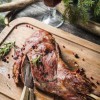 Game meats provide wholesome and nutritious animal protein, but learning the regulations (and which agency has jurisdiction over which regulations) can be burdensome for those who want to be entrepreneurial. This 4-page fact sheet is a “one-stop-shop” for Florida residents who want to sell products from alligators, wild game, or their own farmed game or birds. Written by Chad Carr, Jason Scheffler, Larry Eubanks, Ron Webb, Lee Cornman, Scotland Talley, and Steve Stiegler, and published by the UF Department of Animal Sciences, December 2014. (Photo: iStock/Thinkstock.com)
Game meats provide wholesome and nutritious animal protein, but learning the regulations (and which agency has jurisdiction over which regulations) can be burdensome for those who want to be entrepreneurial. This 4-page fact sheet is a “one-stop-shop” for Florida residents who want to sell products from alligators, wild game, or their own farmed game or birds. Written by Chad Carr, Jason Scheffler, Larry Eubanks, Ron Webb, Lee Cornman, Scotland Talley, and Steve Stiegler, and published by the UF Department of Animal Sciences, December 2014. (Photo: iStock/Thinkstock.com)
http://edis.ifas.ufl.edu/an315
Cull Cow Beef Quality Issues series
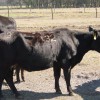 Cull cattle are those that are sold from a herd for lack of performance, lack of resources, or genetic improvement The non-fed beef cattle market (cattle that are not managed through traditional feedlot finishing systems) is comprised primarily of cull cows and bulls. To address liability and food safety concerns, this series of articles discusses some quality defects identified in the non-fed beef market, how to prevent them, and how to address them when they appear in cattle.
Cull cattle are those that are sold from a herd for lack of performance, lack of resources, or genetic improvement The non-fed beef cattle market (cattle that are not managed through traditional feedlot finishing systems) is comprised primarily of cull cows and bulls. To address liability and food safety concerns, this series of articles discusses some quality defects identified in the non-fed beef market, how to prevent them, and how to address them when they appear in cattle.
- Overview of Cull Cow Beef Quality Issues
- Injection Sites and Abscesses
- Horns, Ocular Squamous Cell Carcinoma, and Lumpy Jaw
- Bruising, Condemnation, and Foreign Objects
- Cow Condition and Muscling
- Hide Defects, Contamination, and Non-Ambulatory Cattle
http://edis.ifas.ufl.edu/topic_series_cull_cow_beef_quality_issues